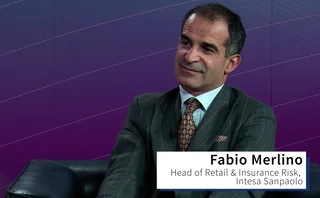
The changing face of Risk.net and our magazines
An extensive reader consultation has helped us reshape editorial teams and our site

Dear reader,
We are making a lot of changes to Risk.net and our magazines, some of them visible – such as the new website, which launched on December 3 – and some less so. I'll try to explain why this is important, and what it means for you.
We believe our readers want deep, analytical coverage of topics other outlets tend to ignore – a conviction strengthened this year by a round of reader consultation. Delivering that kind of content has been our goal since Risk magazine launched 28 years ago, and it remains our defining characteristic.
It takes a lot of effort. We will never churn out dozens of stories a day, so we have to use our resources effectively. We also need to deliver our work in whatever form our readers find most useful.
We thought we could do a better job in both respects, and started by reorganising our editorial team.
Until September, all Risk.net content was taken from seven magazines, each of which had its own editor and journalists. There was no overarching management structure. That made it difficult to ensure consistent standards for the print titles and also to produce a coherent, focused website.
We have now reorganised those separate teams into a single newsroom, built around five desks. Risk Management, Derivatives and Regulation are the first three, representing the core topics in which our broad base of readers is most interested. Our Commodities and Asset Management desks write about the same core topics, but with a sector focus – the last of those two is also responsible for our coverage for life insurers. My role has changed, too – from editor of Risk magazine, to editor-in-chief of Risk.net – and I'm supported by three bureau chiefs, in Hong Kong, London and New York.
In sum, it means we have fewer, bigger teams – each one led by a specialist editor – that share a common focus on our three core topics. For the first time, we have a team dedicated to covering risk management; for the first time, we have a team dedicated to our growing buy-side audience.
The new site reflects this structure. Our top-line navigation matches the five desks; each editor will be responsible for curating the front page of their section.
It's early days, but you can already see some of the benefits. I believe we're picking our targets more effectively, resulting in better, more coherent coverage. And it should now be easier to find material that matters to you.
The new site isn't just about matching the navigation to your interests and our structure, though – you'll see it is being presented very differently, giving us more ways to put content in front of you. The new site is also ‘responsive' – meaning it resizes and reformats automatically for the device on which it is being viewed – and there are attendant benefits in terms of speed. We've also added a number of new features to the site and to article pages, including story-at-a-glance bullet-points at the top of our long-form content, to help those readers who are pressed for time.
You will see more changes in the early months of next year, including a revamped – and more granular – line-up of email newsletters, making it easier for you to stay on top of the key developments in your field.
Our recent acquisition of risk technology research and advisory firm Chartis will also generate new content for subscribers in 2016.
What does all of this mean for our magazines? Well, one way to sum up the reorganisation is to say Risk.net used to be the byproduct of the work that went into publishing those titles each month; now, the magazines are more like ‘Best Of...' collections from the website. And those collections should now be stronger, which is good news for all of our readers who like their content in magazine format, delivered either in print or via our apps.
We like the magazine format – and more importantly you told us you did too – so we're continuing to invest in it.
A final point: we do have a broad church of readers, from central banks and regulators to tech vendors and pension funds. They vary in seniority and work all over the world. We'll continue to write for all of these readers, but we're going to focus on topics where we think we have an edge, and where our research has showed strongest demand – it seems the right way to deliver value for a subscription. But we'll learn as we go, and will continue to tinker. If you have any comments or suggestions, please get in touch: duncan.wood@incisivemedia.com
All the best,
Duncan Wood.
Editor-in-chief
www.risk.net
Only users who have a paid subscription or are part of a corporate subscription are able to print or copy content.
To access these options, along with all other subscription benefits, please contact info@risk.net or view our subscription options here: http://subscriptions.risk.net/subscribe
You are currently unable to print this content. Please contact info@risk.net to find out more.
You are currently unable to copy this content. Please contact info@risk.net to find out more.
Copyright Infopro Digital Limited. All rights reserved.
You may share this content using our article tools. Printing this content is for the sole use of the Authorised User (named subscriber), as outlined in our terms and conditions - https://www.infopro-insight.com/terms-conditions/insight-subscriptions/
If you would like to purchase additional rights please email info@risk.net
Copyright Infopro Digital Limited. All rights reserved.
You may share this content using our article tools. Copying this content is for the sole use of the Authorised User (named subscriber), as outlined in our terms and conditions - https://www.infopro-insight.com/terms-conditions/insight-subscriptions/
If you would like to purchase additional rights please email info@risk.net
More on Infrastructure
SIMONE, the AI that nearly took down a bank
An algorithm designed to create new structured products ran out of control last year with almost catastrophic consequences for a major bank, as our exclusive whistleblower account reveals
Revealed: where banks are (literally) warehousing their swaps
As derivatives notional grows, dealers experiment with novel storage solutions
E-trading takes hold for FX swaps – sort of
Bulk of trades are being executed over screen, but bolder changes have stalled
From DNA to DHA – Preparing for a new era of digital human augmentation
As technology increasingly permeates societies, cultures and everyday activities, its integration into people’s lives is having a profound impact on what is expected of people in the workplace. Deloitte examines this evolution of today’s workforce, the…
Risk and finance: Working more closely together
Video interview: Thomas Kimner, SAS
Video interview: Fabio Merlino, Intesa Sanpaolo
Fabio Merlino, head of retail and insurance risk discusses how the wealth management division of Intesa Sanpaolo upgraded its risk analytics capabilities with the algo system used by its proprietary traders
Fed discount window could resolve CCP collateral liquidity concerns, say clearers
US regulatory concerns about liquidity of government securities collateral could be resolved by access to the Fed’s discount window, CCP officials say
Exchange order types prompt fears of HFT conspiracy
High-frequency traders have been viewed with suspicion for some time. Now critics claim exchanges are conspiring with the traders to develop tools that benefit them and disadvantage ordinary investors. Is the threat real? Laurie Carver reports








